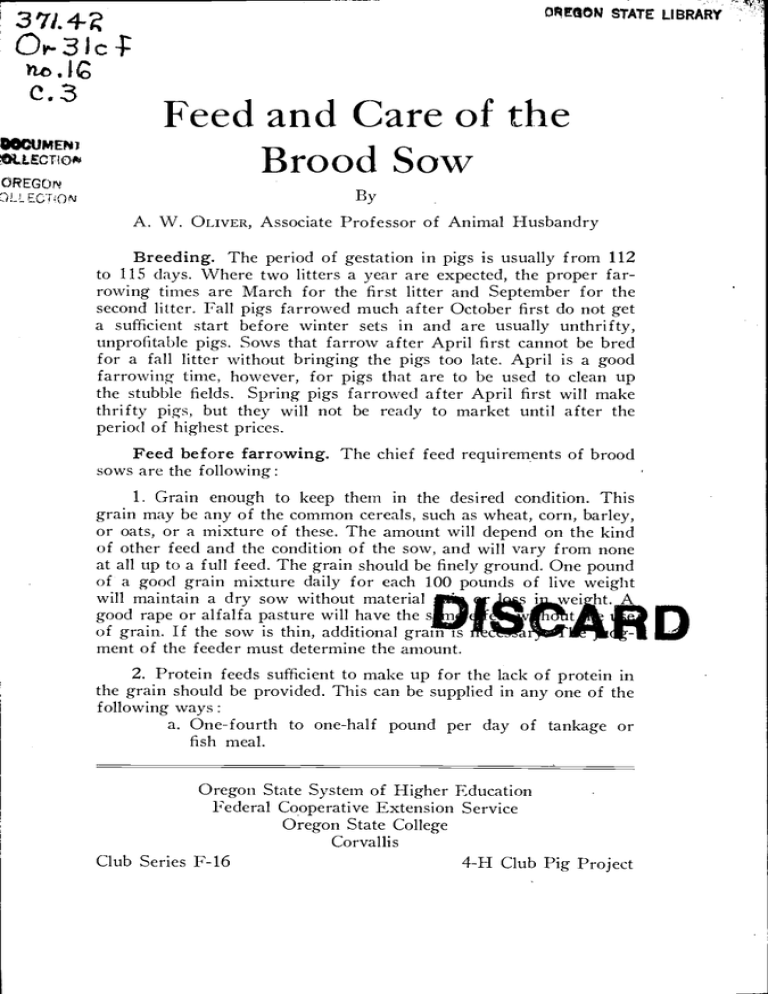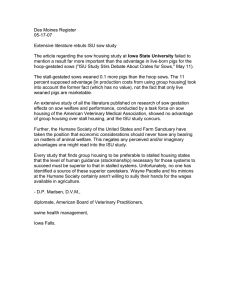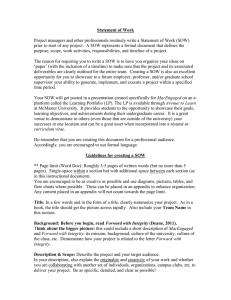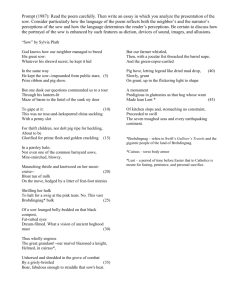Brood Sow Feed and Care of the Qp.31c4
advertisement

OR!ON STATE LIBRARY 3 Ii. 4 Qp.31c4 Feed and Care of the DOCUMEN Brood Sow OREG0 By )LLECTQj A. W. OLIVER, Associate Professor of Animal Husbandry Breeding. The period of gestation in pigs is usually from 112 to 115 clays. Where two litters a year are expected, the proper farrowing times are March for the first litter and September for the second litter. Fall pigs farrowed much after October first do not get a sufficient start before winter sets in and are usually unthrifty, unprofitable pigs. Sows that farrow after April first cannot be bred for a fall litter without bringing the pigs too late. April is a good farrowing time, however, for pigs that are to be used to clean up the stubble fields. Spring pigs farrowed after April first will make thrifty pigs, but they will not be ready to market until after the period of highest prices. Feed before farrowing. The chief feed requirements of brood sows are the following: 1. Grain enough to keep them in the desired condition. This grain may be any of the common cereals, such as wheat, corn, barley, or oats, or a mixture of these. The amount will depend on the kind of other feed and the condition of the sow, and will vary from none at all up to a full feed. The grain should be finely ground. One pound of a good grain mixture daily for each 100 pounds of live weight will maintain a dry sow without material i wei ht. A good rape or alfalfa pasture will have the s of grain. If the sow is thin, additional grain is ment of the feeder must determine the amount. t 2. Protein feeds sufficient to make up for the lack of protein in the grain should be provided. This can be supplied in any one of the following ways: a. One-fourth to one-half pound per day of tankage or fish meal. Oregon State System of Higher Education Federal Cooperative Extension Service Oregon State College Corvallis Club Series F-16 4-H Club Pig Project b. One-half to one gallon a clay of skim milk or buttermilk. c. Plenty of good, succulent pasture, stich as rape, alfalfa, or clover. If the pasture is dry and woody, or short, it will not supply sufficient protein, in which case tankage or milk must be supplied, although in somewhat lesser amount than where there is no pasture. 3. Vitamins may be supplied by good rape, clover, or alfalfa pasture, or by bright-green alfalfa hay, in such amounts as the sow will consume. In the winter in western Oregon, alfalfa meal is fed. 4. Minerals supplied in such quantities as the sow will consume. There are many good formulas for mineral mixtures. The following is in use at Oregon State College : Equal parts of salt, ground limestone, and bonemeal. Minerals may be mixed with the grain at the rate of 1 pound for each 100 pounds of grain, or, after the hogs are accustomed to it. by feeding a small amount daily for a week. The mixture can then be put in a small self-feeder and the hogs given free access to it. A proper supply of protein, vitamins, and minerals is absolutely essential. Lack of these causes weak pigs, small litters, rickets, and many other troubles. Lack of these essentials is also the usual cause of sows eating their pigs. Exercise. Sows that get their feed without rustling for it will not take enough exercise to keep them in vigorous condition. Special precautions are therefore necessary in order to provide exercise, such, for example, as having the house at one end of the lot and the feed trough at the other end. Prevention of roundworms in pigs. The prevention of intestinal roundworms in pigs is much better than the treatment of them after the worms have developed. Most of the damage has occurred before the worms are developed in the intestines. The worm eggs that cause the damage are found in hog lots that have been in continuous use. When these eggs are taken into the digestive tract they hatch into very small worms that go through the walls of the intestines into the blood stream, to the lungs, where they cause the suckling pigs to cough and develop thumps. These small worms are coughed up into the throat and the pig swallows them. When they reach the intestines this time they mature into roun(lworms. '[he best prevention method is to keep the small pigs away from places where the eggs are found. First, the pen where the sow is to farrow should be thoroughly cleaned and scrubbed with boiling water and lye. Second, the sow should be carefully washed with soap and water to remove all dirt and filth before she is put into the pen. After she farrows, the sow and the pigs should be kept inside the pen until the pigs are about a week old, then they should be taken to a clean pasture that hogs have not used for a year, or where the field has been ploughed. It is essential that the sow and pigs are not driven out through the old hog lot; otherwise the pigs will pick up enough dirt that contains worm eggs to infest them, and the sow will get her belly, feet, and legs dirty and the pigs will get eggs out of the dirt when they suckle. If necessary, put a crate on a stone boat that has been placed at the door of the pen and haul the sow and pigs to the clean pasture. In some sections of Oregon sows can be farrowed in portable houses that have been thoroughly cleaned before they are hauled into clean pasture. The pigs should be left in the pasture when weaned and not taken to the old hog lots. After they are 4 to 5 months old they can be taken back to the central barn, as they will not be materially affected by worms after that age. Farrowing. A week before each sow is due to farrow, she should be separated from the herd and placed in a pen by herself so she will become accustomed to her new quarters and be more quiet at farrowing time. The essential features of the farrowing pen are dryness, light, ventilation, freedom from drafts, and a rail to prevent the sow from mashing the pigs against the wall. The floor should be dry, clean and lightly bedded with soft bedding so that the little pigs can walk around without difficulty and thus keep out of the sow's way. About 3 or 4 hours before the sow is to farrow, there will ordinarily be milk in the teats, and she will usually show a great activity in making a bed; but neither of these signs is infallible. If the presence of anyone in or near the farrowing pen seems to annoy the sow, the attendant should keep out of sight. As soon as a pig arrives, if he gasps and gets his breath, the only precaution is to remove the mucous covering from his body and nose and rub him vigorously to get him dry, and even this latter will not be necessary if the weather is warm. If the sow is quiet, it will not be necessary to remove the pigs from the pen. If any pig fails to show signs of life when born, a few slaps on the sides or blowing in its nostrils will usually start respiration if it has any life in it. The afterbirth is usually passed in two installments. It should be immediately removed and buried or burned. All the pigs should be placed with the sow to suckle, if they have not already done so. If there are more pigs than there are good teats, it is advisable to give some of the pigs to another sow, if this can be clone, and if not, raise the weak ones by hand. The above are only general suggestions and must be modified to suit the occasion. Much can be done with a quiet sow, while an irritable sow may save more pigs if left entirely to herself. One must use judgment and not be tied too tightly to any regular routine. Feed for the sow and pigs. After the pigs come, the sow should be given very little feed for a day or two, and that mostly in the form of warm slop. From then on, however, the feed should be increased gradually. The rate of increase will depend somewhat on the condition of the sow and the size of the litter. Sows that are very heavy milkers and have small litters might be fed too much, but in the great majority of cases the pigs need all the milk they can get; hence we increase the feed of the sow so that by the end of a week or 10 days she will get all the grain that she can eat. Pigs make the most economical gains while suckling the sow; hence, it is poor economy to skimp the feed at this time. If the sow is a good milker, she will lose flesh no matter how she is fed. The sow with suckling pigs will require twice as much protein as she needed before farrowing. Various grain combinations may be used. Probably the best is a combination made up of 50 to 60 per cent corn, wheat, or barley and the remainder of oats or middlings, all supplemented, of course, by tankage, fish meal, skim milk, or buttermilk. Pasture will not ordinarily afford enough protein for a sow suckling a large litter. A suggested ration for a sow with suckling pigs is: Ground wheat, ground barley, or corn ------------------------ 60 pounds Ground oats or middlings 25 pounds Tankage------------------------------------------------------------------------------ 10 pounds Alfalfameal ---------------------------------------------------------------------- 5 pounds Skim milk, if available, can replace tankage and alfalfa meal can be omitted when the sow is on pasture. When the sow and pigs are kept inside, away from the ground, some dirt or soil should be put into the pen. This will prevent anemia of the pigs. A shovel of soil from a field that hogs have not been using for a- year should be put into the pen at least three times a week. Some people like to throw in bunches of sod, which is satisfactory. To be successful, it is necessary to put the sow and pigs on clean pasture. cooperative Extension work in Agriculture and Home Economics Wm. A. Schoenfeld, Director Oregon State College, United States Department of Agriculture, and State Department of Education, Cooperating Printed and distributed in furtherance of the Acts of Congress of May 8 and June 30, 1914





